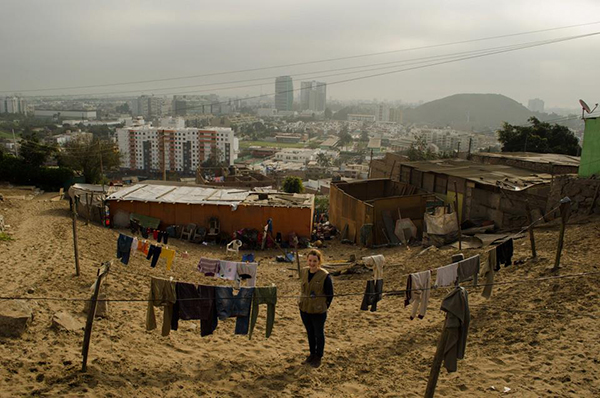Ben and I decided to eat a sturdy lunch that day. We didn’t know what Carlos had in store for us in the field that afternoon. In the past we had done all kinds of things under Carlos’s guidance, from hiking way up the hills of Pamplona Alta to visiting patients in distant areas. What we hadn’t anticipated was visiting the old part of a particularly green area within Lima called Surco, which Carlos fondly referred to as the “lung of the environment.” This was swiftly followed by a trip with two men from the municipality to a little patch of land in the outskirts of Surco that overlooked greenery, but had none itself.
During the first part of our trip we strolled through a lush part of Surco, amazed by its beautiful parks with vibrant with colors, fountains and remnants of Surco’s ancient vineyards. In comparison to the other places we had visited previously with Carlos this place seemed like a beautiful palace with modern services and infrastructure, parks, and more. Carlos himself muttered that he would have to ‘see it to believe it,’ referring to the areas of poverty the men of the municipality had promised to take us to that day. While we waited for the men, Carlos cured Ben’s and my slight disbelief in the rumored weekly cockfights held in this area of Surco by taking us to see an actual coliseum where the fights took place, slightly hidden at the back of a restaurant. We couldn’t decide if it would be cool or gruesome to entertain this tradition at some point during our time in Lima. We then proceeded to the beautiful ‘Parque de Amistad’ and climbed the huge arch in the middle. From the top of the arch we got a clear view of the ‘Muro de Verguenza’ (wall of shame), which is a plain, high wall with barbed wire at the top effectively and bluntly dividing the wealthy Surco inhabitants from the deprived residents of Pamplona.
We were in high spirits when we met the two friendly men from the municipality who told us of the various social programs they were able to set up in Surco and their hopes to cooperate with MEDLIFE to help these pockets of poverty on the outskirts of Surco. While we were driving we passed by a huge, modern looking building that proclaimed ‘US Embassy’ both by the large lettering on the front wall as well as the large US flag billowing in the wind. Only five minutes later we arrived at our destination – a whole different scene. Though the government had already built some stairs to facilitate getting up and down the hill that this little village was situated on, there was still a fair amount of sandy road to be walked in order to get to the edge of this specific village. From there we had the perfect view of the richness of Surco. All the greenery, the US Embassy, clay tennis courts… but here the community members explained that they had no water, electricity, proper sewage system and no proper roads! One lady told me that a man died this past year because the community members were unable to get him to the hospital on time due to the lack of roads. The men from the municipality, Carlos and some community members discussed the possibility of development projects for this community as well as organizing a mobile clinic, both of which the community was obviously in dire need of.
In these poorer and out of the way areas in Peru there is a huge distrust of the government. People often experience politicians promising them change and improvement but after getting voted into their position do not keep their promises at all. Especially therefore it was wonderful to see that these government workers were genuinely concerned enough with this community to contact MEDLIFE for help and ‘get their shoes dirty’ both literally and metaphorically by going up and visiting the community themselves. Though it was shocking to see the completely different lifestyles within such a short distance, I believe seeing the government and an NGO cooperate to help the poor generates a lot of hope and that this is the best way to create sustainable, positive change.

